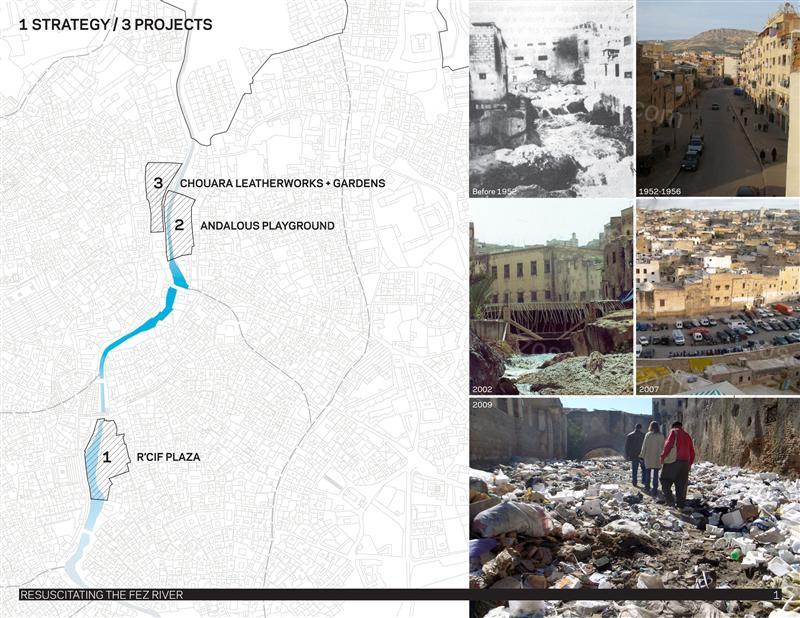Fez River Project费兹河河流保护修复景观规划设计
区域生态景观规划
2015-5-12 21:00
3221人浏览
0人点评
摘要
Fez River,菲斯古城的文明发源地。在历经千年的沧桑变迁之后,它已变得满目疮痍。沿岸公共空间的缺失、水质的严重恶化以及皮革产业结构的极度不合理俨然成为困绕古城多年的顽疾。以Aziza Chaouni和Takako Tajima为 ...
|
Fez River ,菲斯古城的文明发源地。在历经千年的沧桑变迁之后,它已变得满目疮痍。沿岸公共空间的缺失、水质的严重恶化以及皮革产业结构的极度不合理俨然成为困绕古城多年的顽疾。以Aziza Chaouni和Takako Tajima为首的景观建筑设计团队经过长时间的实地考察,在充分尊重当地文化的基础上设计了一套完善而又温和的可持续河流整治方案,奄奄一息的古城母亲河将又一次迎来彻底的脱胎换骨! Fez River Project费兹河河流保护修复景观规划设计 景观建筑设计师开始探索一套温和且具有可持续性发展的河流水质净化改造方案以此来拯救菲斯古城的心脏区域。这其中包括了一系列的地区干预,如恢复湿地、创造社区公共空间与人行道以及翻新和改革当地的皮革制造业等等。该项目不仅仅只关注建筑与城市规划本身,还将城市的经济生活与河流的生态作为一个整体来思考,创造出一条更加健康合理的经济产业链。其核心部分修复了史上著名的麦地加建筑,使得整个生态环境更具多功能性与可存活性。 在老一辈菲斯人心中,Fez River 是他们的母亲河。它曾贯穿整个菲斯城,为城市带来肥沃土壤和充沛水源。它曾经清澈见底,鱼虾成群。作为土生土长的菲斯人,建筑师Aziza在电话中坦言自己对菲斯河的美好想象完全来自于祖母的口述和照片。从小她就目睹人们向河中倾倒大量的生活垃圾和厕所污秽物。在进行项目的前期调查工作时,她曾让生活在菲斯河沿岸地区的居民畅谈对河的看法。只有年龄稍长者还保留一些陈年记忆,而很多当地的年轻人似乎对其了解甚少。一个女孩甚至从未听说过这条河——此时她正站在干涸已久的菲斯河床上。 The City of Fez Department of Water and Power (RADEEF) is currently implementing a new system which will channel the city’s water sewage towards two treatment plants. Thereby, the Fez river will soon stop receiving backwater and regain its potential as a public amenity. If rehabilitated, its impact will be inordinately salient to the unique urban context of Fez. Indeed, the medina’s intra-mural population not only lacks public open spaces, but is also experiencing a rapid deterioration of its environment due to over-densification and aging public infrastructure. In support of its current initiative, the RADEEF commissioned us to propose a rehabilitation plan for the river as well as acupunctural interventions along its banks within the most critical site, the medina. Our proposal is a strategic plan that addresses not only the ecology of the river but also the social and economic concerns of the city. It works at two scales—the city scale and the site scale. Based on an in-depth analysis of Fez’s urban and ecological context, the project at the city scale (City of Fez including the ville nouvelle and the medina) is a master plan with recommended measures for improving regional water quality. Depending on soil geomorphology, levels of water pollution, adjacent urban fabric and ecological systems, different rehabilitation tactics are purposefully located, such as canal restorers, constructed wetlands, bank restoration and storm-water retention ponds. |





